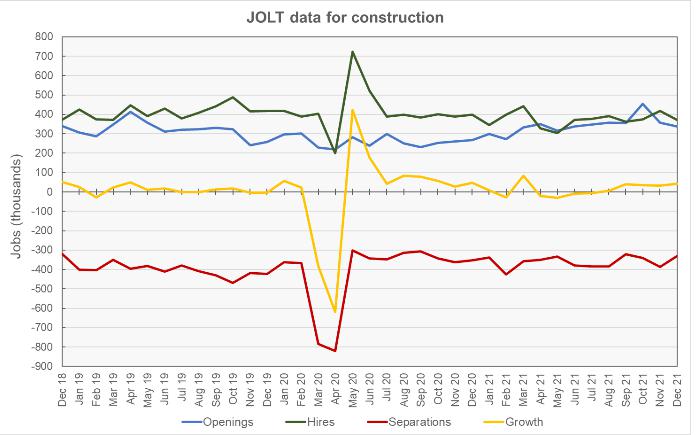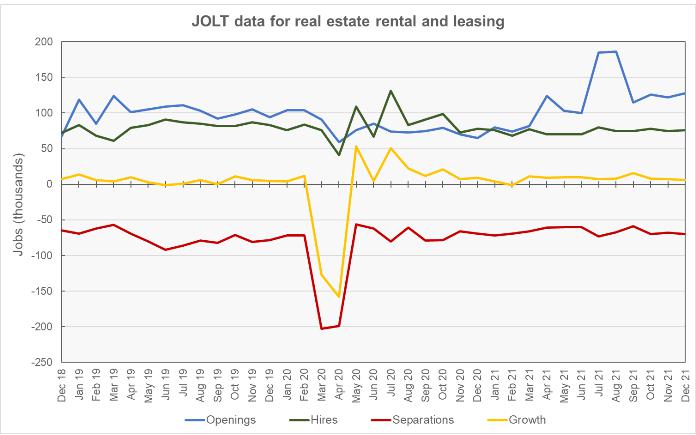The December Job Openings and Labor Turnover (JOLT) report from the Bureau of Labor Statistics (BLS) said that the number of job openings increased slightly for the month. Both hiring and separations fell, but there was positive job growth for the month.
Overall jobs market shows gains
For a discussion of the JOLT report and how it relates to the Employment Situation Report, please see the paragraph at the end of this article.
The BLS reported that there were 10.9 million job openings at the end of December. This was up by 363,000 from the preliminary level reported last month. The December job openings figure represents 6.8 percent of total employment plus job openings. For comparison, the unemployment rate in December was 3.9 percent and 6.3 million people were unemployed. Another 5.7 million people said that they would like a job but were not counted as being in the labor force since they were not actively seeking employment.
The number of people hired for a new job in December was 6.26 million while the number of people leaving their old jobs was 5.90 million. Of those leaving their jobs, 4.34 million (74 percent) quit voluntarily, while 1.17 million people were involuntarily separated from their jobs. The remainder of people leaving their jobs left for other reasons, such as retirements or transfers.
The portion of people quitting their jobs fell slightly to 2.9 percent of the labor force. The involuntary separations rate fell to only 0.8 percent, the lowest level seen in this data series, indicating that employers sought to hold on to their current employees.
Construction jobs grow
The first chart, below, shows the employment situation for the construction jobs market over the last 37 months. It shows that December saw a net rise of 43,000 jobs, up from the revised (+12,000) rise of 32,000 jobs reported for November.

Construction jobs openings in December were reported to be 337,000 jobs, 26 percent higher than the year-earlier level. On a month-over-month basis, openings for construction jobs were reported to fall by 21,000 openings or 6 percent, aided by November’s figure being revised upward by 13,000 openings.
Hiring was reported to be down 46,000 jobs in December from November’s revised (-4,000 jobs) figure. The BLS reported that 373,000 construction jobs were filled in December, 26 percent below the year-earlier figure.
Construction jobs separations were reported to fall by 57,000 jobs in December to 330,000 jobs. Quits fell by 44,000 jobs to 181,000 jobs. Layoffs were reported to fall by 24,000 to 131,000 jobs. “Other separations” which includes retirements and transfers, were reported rise by 10,000 jobs from November’s revised figure to 19,000 jobs. Quits represented 55 percent of separations for the month.
RERL jobs growth continues
The last chart, below, shows the employment situation for the real estate and rental and leasing (RERL) jobs category. Job growth in this category was 6,000 jobs, extending its positive streak of job growth to 10 months.

The number of job openings in the RERL category was 128,000 jobs at the end of December, up 6,000 jobs from the revised level (-9,000 openings) of the month before. Job openings in December were 97 percent higher than their year-earlier level.
Hiring in December was nearly unchanged from November’s level at 76,000 jobs. This hiring figure was 3 percent below the year-earlier level.
Separations in the RERL jobs category in December were up 3 percent from November’s revised figure (+6,000 jobs) to 70,000 jobs. Quits were nearly unchanged from November’s revised (-6,000 jobs) figure at 52,000. Quits represented 74 percent of total separations in December.
The numbers given in the JOLT report are seasonally adjusted and are subject to revision. It is common for small adjustments to be made in subsequent reports, particularly to the data for the most recent month. The full current JOLT report can be found here.
Comparing the reports
The US labor market is very dynamic with many people changing jobs in any given month. The JOLT report documents this dynamism by providing details about job openings, hiring and separations. However, it does not break down the jobs market into as fine categories as does the Employment Situation Report, which provides data on total employment and unemployment. For example, while the Employment Situation Report separates residential construction from other construction employment, the JOLT report does not. The Employment Situation Report separates residential property managers from other types of real estate and rental and leasing professionals, but the JOLT report does not. However, the JOLT report provides a look at what is driving the employment gains (or losses) in broad employment categories.












